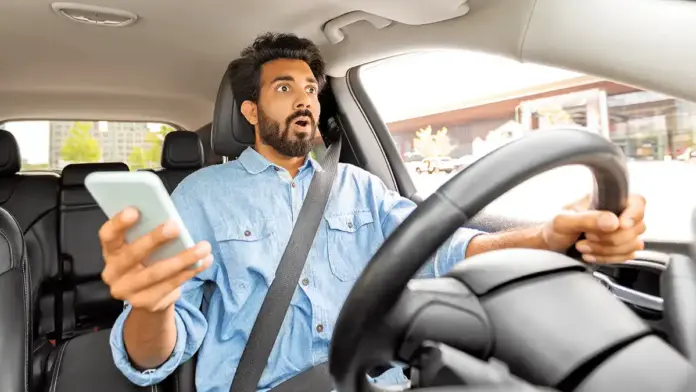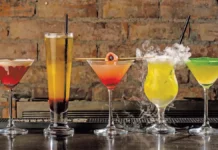
For those who don’t possibly know, Superman was the quintessential superhero with some amazing powers. Not unlike the way you look at your restaurant’s delivery program!
Well, believe it or not, there was actually one thing that could stop him in his tracks, and that’s Kryptonite. The fictitious mineral from Superman’s home planet, Krypton, and had the unique ability to weaken him.
I have studied the delivery business for decades and we actually wrote a book about it: Delivery Master USA. In analyzing what makes delivery programs successful and what makes them fail, I have found our industry’s Kryptonite. Even with all of the technology that has flooded the marketplace and theoretically made delivery easier, the same obstacle exists today: DISTRACTED DRIVING!
You would have thought that with publicly traded companies: UberEats, DoorDash, would have fought and won the battle to eliminate distracted driving by its delivery personnel. What used to be drinking a Coke and/or smoking a cigarette has evolved into a multitude of distractions led by the cell phone.
There is some good news when it comes to cell phone use behind the wheel. While 2.5% of drivers used their cell phones while operating a vehicle in 2021, this number is less than half of the 5.2% of drivers using their phones in 2012. Although cell phone use has declined since 2012, drivers are faced with new distractions thanks to the rise of infotainment systems and in-vehicle screens. Due to this new technology, using devices while driving increased from 1.5% in 2012 to 3.4% in 2021.
The Centers for Disease Control and Prevention has identified three kinds of distracted driving. They are: visual distractions that cause you to take your eyes away from the road. This can include using a GPS, looking at a billboard, rubbernecking an accident, checking out the scenery or even looking at other cars surrounding you instead of those directly in your path and adjacent to you.
The second is manual distractions that cause you to remove your hand from the wheel. Behaviors such as eating while driving, using your phone, changing the radio station or reaching for something in the car are all examples of manual distractions. Finally, the CDC points to cognitive distractions that take your mind off of driving. Singing, talking, daydreaming or worrying all fall into this category.
Needless to say, the potential consequences of distracted driving, such as accidents, injuries, and legal repercussions is never ending. Trust me ns working on the Delivery masters guide, if the Pandemic had driven takeout & delivery revenue to such dizzying heights, I don’t know if delivery would even be viable. We all understand, and I suppose to some extent empathize with the unique challenges faced by delivery drivers, including time pressure, multitasking, and the temptation to engage in distracting behavior.
The statistics and studies that demonstrate the prevalence of distracted driving among delivery drivers. Since 2016, between 8% and 9% of fatal crashes have involved distracted driving. In 2020, the most recent year for which data is available, these collisions accounted for 8% of deadly accidents. While this is a far lower percentage of crashes than impaired driving, which accounts for approximately 30% of all fatal accidents, it still reflects the extreme risk presented by driver distraction.
Distracted driving costs lives throughout the year. A total of nine people die every day in the United States from distracted driving.
It is not just drivers in motor vehicles who are affected by distracted driving. Pedestrian accidents are also common. A total of 587 pedestrians and bicycle riders lost their lives in 2020 as a result of actions caused by inattention. These non-occupants may have lost their lives to drivers who were not paying attention or may have been distracted and made dangerous choices that contributed to collisions.
Based on our firsthand analysis and insight of what leaders in our industry are doing correctly to mitigate these risks, here are some of our suggestions. The immediate steps need to include educational programs and workshops with ESL to teach drivers about the dangers of distracted driving and provide strategies to stay focused.
We suggest looking at a reward-based system that incentivizes safe driving behaviors, such as offering discounts or subsidized insurance premiums or providing monetary rewards for drivers who consistently drive without distractions. Think “flight simulator” or video games and take a look at virtual reality training programs that simulate different driving scenarios and help drivers practice staying focused in realistic situations.
Down the road, start thinking about developing a mobile app that uses artificial intelligence to detect when a driver is distracted and provides real-time alerts and reminders to stay focused on the road. Anybody that plays golf, knows that when that cart goes somewhere it doesn’t belong on the golf course, an alarm sounds or even a hard stop.
How about installing a device that can detect when a driver is using their phone while driving and automatically sends a notification to their emergency contacts, alerting them of the dangerous behavior? I’m sure it’s just a matter of time before a wearable technology will be available, such as a smartwatch or glasses, that can monitor a driver’s eye movements and alert them when they are not paying attention to the road.
How about this to start: We suggest providing your drivers with a supply of dog treats. Nothing creates more peril than a driver pulling up to a house and not being able to make the delivery due to a barking or over enthusiastic canine.
A smart approach for a restaurant that is going to “self op” delivery needs to include three key points. The foodservice operator needs to rethink your hiring strategies, implement strict policies, providing driver education, and utilize technology solutions.
We all love giving that teenager their first job opportunity. But the facts show it’s a big risk. 6% of Distracted Driving Fatalities Included a Teenager (15-19 Years Old). Young drivers may be more connected to technology than their older counterparts and less able to access and respond to risks on the road. This helps to explain why 265 people died in motor vehicle accidents involving a distracted teen driver in 2020.
When teens are distracted behind the wheel, these drivers or their young peers are often harmed by driver inattention. In fact, in 44% of distracted driving accidents that resulted in fatalities, the deceased victim was between 15 and 19 years old. These tragic crashes resulted in 186 teens dying due to driver distraction in 2020.
One thing that has not changed since our initial publishing of the Delivery Master guide is your ability as a leader to instill the same pride you put in your delivery team that you have dedicated years to doing with your front of the house waitstaff and management and your culinary team in the kitchen. Advocating for increased awareness and accountability among delivery drivers themselves will go a long way to solving your DISTRACTED DRIVER challenges.
We encourage the restaurant community’s leadership to prioritize safety and support initiatives aimed at reducing distracted driving among delivery drivers. Whether it’s with a copy of our guide or a simple question of how to get started, we are here to help.

























